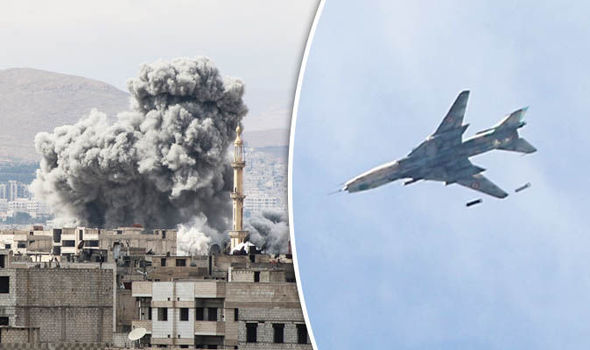The Washington Post
The United States is becoming more perilously drawn into Syria’s fragmented war as it fights on increasingly congested battlefields surrounding Islamic State territory.
On Sunday, a U.S. fighter jet downed a Syrian warplane for the first time in the conflict. By Monday, a key ally of President Bashar al-Assad, Russia, had suspended a pact used to prevent crashes with the U.S.-led coalition in the skies over Syria and was threatening to target American jets.
Separately, Iran said that it had launched a barrage of missiles into Islamic State territory in eastern Syria. That assault marked Tehran’s first official strike against the extremist group in Syria, and it signposted the reach of its military might against foes across the region.
The incident followed a series of U.S. airstrikes against Iran-backed forces advancing on partner forces in a strategically prized swath of land along the Iraqi border.
As the major powers on the opposite sides of Syria’s war intensify operations against the Islamic State, the risks of an accidental conflagration appear to be growing by the day.
The United States intervened in Syria to roll back Islamic State forces from a self-declared caliphate that once stretched deep into Iraq. But the American role has unsettled Assad’s allies, threatening confrontation with Russia and thrusting Iranian-backed militiamen in a race with a U.S.-favored rebel force to reach the Islamic State’s eastern strongholds.
The U.S. military confirmed late Sunday night that a U.S. F/A-18 Super Hornet shot down a Syrian Su-22 fighter-bomber.
The confrontation took place near the onetime Islamic State stronghold of Tabqa, hours after Syrian government forces attacked U.S.-backed fighters, known as the Syrian Democratic Forces, or SDF. It was the first time that the American military has shot down a Syrian warplane during the six-year conflict.
On Monday, Russia condemned that strike as a “flagrant violation of international law” and said its forces will treat U.S.-led coalition aircraft and drones as targets if they are operating in Syrian airspace west of the Euphrates River while Russian aviation is on combat missions.
Pavel Baev, who studies the Russian military at the Peace Research Institute Oslo, called the threat “mostly a bluff” but said that “calling it is risky because there are some nervous fingers on many buttons.”
In a statement Monday, the SDF warned that it would retaliate in the face of further aggression from pro-Assad forces, raising the possibility that the United States could be forced to deviate further from its stated policy in Syria, which involves targeting Islamic State militants only.
The U.S.-backed military alliance is making its way through the outskirts of the Islamic State’s stronghold of Raqqa, backed by U.S.-led coalition airstrikes. The alliance is dominated by Kurdish forces but also includes Arab forces.
If it again comes under attack by pro-Assad forces, Washington may be forced to defend the coalition at the risk of sparking a tinderbox of tensions with Iranian and Syrian troops in the northern province.
“The only actions that we have taken against pro-regime forces in Syria — and there have been two specific incidents — have been in self-defense. And we’ve communicated that clearly,” said Gen. Joseph F. Dunford Jr., chairman of the Joint Chiefs of Staff.
But Monday, the Russian Defense Ministry said it was suspending the communication channel through which such messages had been shared in order to minimize the risk of in-flight incidents between Russian and U.S.-led coalition aircraft operating over Syria.
Dunford said the two sides discussed the matter as recently as Monday morning but that further talks are required.
“We work very hard on deconfliction. We’ve spent the last eight months on deconfliction,” Dunford told reporters at the National Press Club. “It’s going to require some military and diplomatic efforts in the next hours to restore deconfliction.”
Col. Ryan Dillon, a spokesman for the U.S.-led coalition, said that “appropriate platforms” had been dispatched to help ensure operations would continue against the Islamic State, an apparent reference to U.S. aircraft designed to intercept enemy jets.
“Engaging in a game of chicken is not what the military on both sides would enjoy, but they are just instruments of politics, which is not anywhere close to rational at this moment, neither in Moscow, nor in D.C.,” Baev said.
In Moscow, officials said that Sunday’s shoot-down was intended as a message aimed squarely at Russia.
Frants Klintsevich, deputy head of the defense and security committee of the Russian upper house of parliament, called the incident “an aggression and a provocation.”
“It looks like Donald Trump’s United States is a source of a brand-new danger both in the Middle East and the world at large,” Klintsevich wrote on his Facebook page.
But some analysts said Sunday’s strike was an indication of the growing willingness on the part of Assad’s forces to confront the U.S.-led coalition as it jostles to push Islamic State militants out of eastern Syria.
That effort has been bolstered by the arrival of thousands of Shiite militiamen who had fought in a campaign across the border in Iraq to capture the city of Mosul from Islamic State militants.
“The wild card here is the logic of an Assad regime which has decided that it no longer wants to be constrained to a Western Syria-based statelet,” said Nicholas A. Heras, a fellow at the Washington-based Center for a New American Security.
That shift has been driven by an assessment that the Trump administration could use the territory its forces capture as a bargaining chip with which to push Assad into a political transition or Syria into a decentralized political system, Heras added.
“This is now an existential issue for them,” he said.

